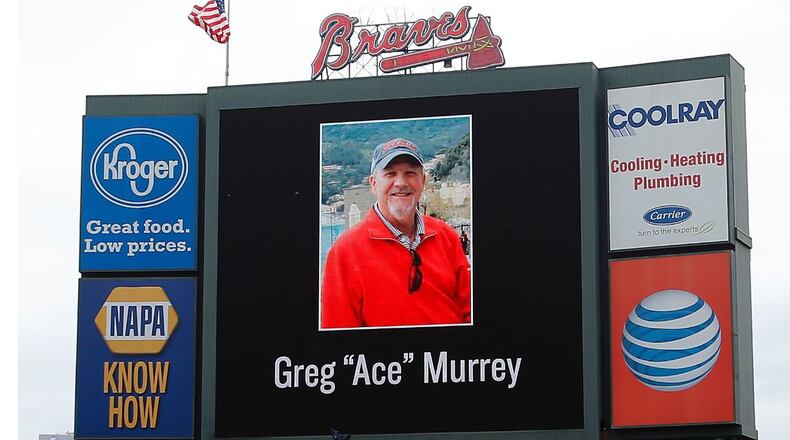Just six days after a Texas baseball fan fell over a railing to his death in 2011, an insurance broker for Major League Baseball sent the league a sobering memo.
BWD Group’s Michael Schmidt wrote that he had just paid a visit to Dodger Stadium and looked for ways a fan could fall over a protective railing to the ground below.
“In Los Angeles as well as other ball parks, it is not that difficult for a fan to lose their balance and take a header over the railing, such as what happened in Texas,” Schmidt wrote. “The best solution is safety netting under each of the decks that can be effectively fastened to the concrete.”
That memo may turn out to be a key piece of evidence in an ongoing lawsuit against the Atlanta Braves and MLB. The suit was filed by Laura Murrey, whose 60-year-old husband died after falling over a 30-inch-high railing to the lower level at Turner Field.
The lawsuit accuses the Braves and MLB of negligence, arguing Murrey would not have died if the railing had been taller. "Another inexpensive safety precaution, protective netting, would also have easily prevented Greg's death," the suit said.
In court filings, the Braves and MLB have denied the lawsuit’s accusations.
There is no indication that Schmidt ever sent the memo to the Braves. In pretrial testimony, former Braves president John Schuerholz defended the safety of Turner Field’s railings, noting they were above the minimum height required by building codes. “We felt like we were doing things correctly,” he said.
“Fan safety is very important to the Atlanta Braves,” the team’s spokeswoman, Beth Marshall, told The Atlanta Journal-Constitution on Thursday. “Since this is an ongoing case and is subject to pending litigation, we believe it’s inappropriate to comment further.”
The case is scheduled to go to trial in Fulton County State Court in November.
Schmidt's July 13, 2011 memo came to light after The AJC and WSB-TV filed a court motion seeking a halt to the Braves and MLB from filing records under seal or after being heavily redacted during the ongoing litigation. Numerous documents such as the memo have since been unsealed, although many more remain confidential.
More documents should be made public, said Atlanta lawyer Cynthia Counts, who filed the motion on behalf of the AJC and WSB-TV.
Schmidt wrote the memo just six days after 39-year-old firefighter Shannon Stone flipped over a 30 1/2-inch railing at the Texas Rangers’ stadium while trying to catch a ball tossed to him by outfielder Josh Hamilton. He died after falling 20 feet to the concrete flooring below, as his young son Cooper looked on.
The Rangers never installed netting but just weeks before the 2012 season, the Rangers spent $1.1 million to raise their railings to 42 inches. (The railings at the Braves’ stadium, SunTrust Park, are 36 inches tall, according to court filings.)
In his memo, Schmidt said increasing the height of the railings would “only serve to decrease the ability of the fan to enjoy the game,” a reference to blocking a spectator’s line of sight to the field. Because of that, he recommended the netting.
In a pretrial deposition, Anthony Avitabile, MLB’s vice president of industry risk management, acknowledged receiving the memo. He also said Schmidt sent a picture that showed netting used at a temporary construction site.
“It just didn’t seem like something that would be appropriate for ballparks,” Avitabile testified.
Avitabile acknowledged that ballparks in Chicago and Seattle have netting near their outfield walls. And he said in the mid-2000s, some fans deliberately jumped into the nets at Yankee Stadium during a game. “It almost invited some other injuries,” Avitabile said.
“Did the fans that jumped into the nets die?” Michael Neff, one of the Murrey family’s attorneys, asked.
“I don’t believe they did,” Avitabile replied.
Tom Eaton, a professor at the University of Georgia School of Law, called Schmidt’s memo “a very powerful piece of evidence” for Laura Murrey’s lawyers.
In order to prove negligence, her lawyers have to show that a risk of injury was foreseeable, and the memo establishes that, Eaton said. Murrey’s lawyers also have to show that there were reasonable safety precautions that could have been taken to prevent fans from falling.
“This memo is relevant to establish: A, you know the danger, B, you know there is something you can do about it and, C, the precaution is both technologically and financially feasible,” Eaton said.
Elizabeth Weeks, another UGA law professor, agreed the memo put the Braves and MLB on notice there was a risk and something could have been done about it.
“The challenge for (Laura Murrey’s) case is that negligence does not require perfect safety or accident avoidance at all costs,” she said. “It merely requires the defendant to exercise ‘reasonable care,’ a flexible standard that changes with the circumstances and depends on the jury’s judgment about what’s ‘reasonable.’”
The tricky part for jurors who hear the case will be that while they are inclined to say more should have been done to avoid the tragic accident, they are supposed to make that judgment from the perspective of the Braves and MLB at the time of the accident, she said.
To that point, the memo could be important, Weeks said. “It offers a suggestion that the defendants could have and, thus, arguably should have, done more.”
In a recent telephone interview, Schmidt said he was advising and consulting with MLB on risk-management and safety issues at he time he wrote the memo.
“It is strictly up to the league if they want to accept or turn down any of our recommendations,” he said. “There’s always the balance between the risks and the fans’ experience.”
Schmidt added, “If it was me, I would have had the barrier — the netting — there.”
Story so far:
Aug. 29, 2015 — Greg Murrey stands up from his second-row, upper-deck seat at Turner Field, but loses his balance and tumbles over railing to his death about 40 feet below.
April 19, 2016 — Murrey's widow, Laura Murrey, files suit against the Atlanta Braves and MLB accusing them of negligence. The suit contends if the guardrail had been taller or if netting had been installed her husband would not have died.
Nov. 15, 2018 — The Atlanta Journal-Constitution and WSB-TV file a court motion asking a judge to stop allowing MLB and the Braves from sealing and redacting court documents being filed in the ongoing litigation.
February 2019 — Attorneys for all parties agree to unseal and remove redactions from some, but not all, of the documents that had previously been filed in the case.
About the Author
The Latest
Featured




